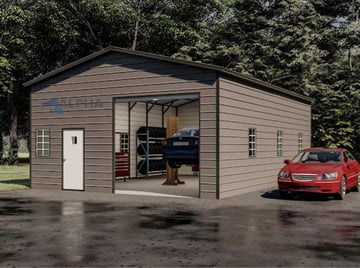Steel Barns vs. Pole Barns

You don’t need to be a farmer to own a barn. Although they may seem antiquated, metal barns are a great asset for agriculture, storage, recreation, and many other applications.
When people start shopping for barns, they are often confused by the difference between pole barns and steel barns—and which option best suits their needs. We want to clear up that confusion and offer a comprehensive list of pros and cons for both steel barns and pole barns.
Metal barns are sometimes mistakenly called pole barns, but a true pole barn always uses wooden supports.
To decide which metal barn kit is right for you, consider the following factors:
- Aesthetics
- Framing
- Pests
- Fire Hazards
- Cost of Materials
- Cost of Maintenance
What is a Pole Barn?
Pole barns are stabilized with wooden poles, which are anchored in the ground. Usually, pole barns have metal walls and only use wooden poles for structural support.
You may hear some people may refer to a “metal pole barn,” but this is technically a misnomer.
Ultimately, the frame is the only element that distinguishes a pole barn from a steel barn. This may seem like a small distinction, but it can have big consequences.
If you prefer a traditional barn aesthetic, a pole barn is a good option. Wooden poles connote time-honored building styles and make a striking addition to any barn.
However, pole barns also involve a number of risks. Wooden poles are more susceptible to pests like rats, termites, and carpenter ants. They also rot much more easily than steel, even if they are treated properly.
If you live in an area with wildfires, pole barns may not be the best fit. Obviously, wood structures are much more prone to fire damage.
Due to ongoing fluctuations in material prices, wood is extremely expensive at the moment. It requires a higher upfront cost in addition to a higher cost for ongoing maintenance. As the price of lumber normalizes, it may reach parity with steel.
It’s also important to note that pole barns generally rely on five-foot spacing between supports. Steel barns have more variable options when it comes to spacing.
What is a Steel Barn?
A steel barn is a 100% metal structure with a reputation for durability and flexibility. If you deal with extreme climate conditions, a metal barn kit is probably the right option, as metal buildings in inclement weather hold up extremely well. Steel barns are less susceptible to pests, wind, and fire. In fact, steel can be as much as 40% cheaper to insure.
Metal barns are made entirely from pre-fabricated steel parts, including support beams. The streamlined construction process guarantees consistent craftsmanship and reliable materials.
Pros and Cons of Pole Barns
Pole barns can be easier to build because they don’t require a slab foundation. Historically, pole barns had a lower upfront cost, but due to a lumber shortage, they are currently more expensive.
Wooden supports are lighter weight, which makes construction easier but reduces the overall durability of your barn. You should expect to do regular maintenance on wooden poles, which makes their lifetime cost much higher than steel barns.
If you use your barn to house livestock, be wary of wooden poles. In rare instances, livestock can dislodge wooden poles from their anchors.
Pros and Cons of Steel Barns
As we’ve already mentioned, steel barns are less expensive to install and maintain. Rest assured that your steel poles will withstand pests, hazardous weather, and collisions with livestock.
Steel barns are easier to clean, increase insurance savings, and enhance property value. Unless you have a strong preference for a more conventional barn appearance, a metal barn kit is most likely the right choice.
Because steel is stronger than wood, metal barns allow for 5, 10, 15, and 20-foot spacing between supports. With a steel barn, you can enjoy an open patio without invasive wooden supports every five feet.
If safety is your prime concern, steel holds up better under stress. It can withstand heavy snow loads and strong winds. Even better, it is not sensitive to rust or rot. If you follow common-sense practices as a homeowner, your metal barn will last for many years.
Cost Considerations
To get the best bang for your buck on these barns, build a structure within certain dimensions. As the dimensions increase, the price can rise exponentially.
Create a 12-24 foot wide center section that doesn’t exceed 40 feet in length. Then add space to your floorplan with a standard 12-foot lean-to. Although Alpha Structures doesn’t offer price guarantees, a steel barn of these dimensions will be cheaper than wood in virtually all scenarios.
Related Content: How Much Does a Metal Barn Cost?
Regardless of your needs, Alpha Structures can help you add livable space and storage to your property. Reach out to Alpha Structures today and breathe easy with a dependable pre-fabricated steel barn.
Comments
Recent posts
-

 4 REASONS WHY STEEL STORAGE BUILDINGS OUTPERFORM WOOD GARAGES
A metal garage is the greatest way to ensure that your automobiles and workplace...
December 11, 2022
4 REASONS WHY STEEL STORAGE BUILDINGS OUTPERFORM WOOD GARAGES
A metal garage is the greatest way to ensure that your automobiles and workplace...
December 11, 2022
-

 Top 7 Uses for a Small, Attractive Commercial Metal Building
You know that old saying, "size doesn't matter?" Well, that rings true for comme...
December 11, 2022
Top 7 Uses for a Small, Attractive Commercial Metal Building
You know that old saying, "size doesn't matter?" Well, that rings true for comme...
December 11, 2022
-

 Do Steel Storage Buildings Add Home Value: 7 FAQ Answered
Adding a garage to your property is one of the smartest investments you can make...
November 28, 2022
Do Steel Storage Buildings Add Home Value: 7 FAQ Answered
Adding a garage to your property is one of the smartest investments you can make...
November 28, 2022



